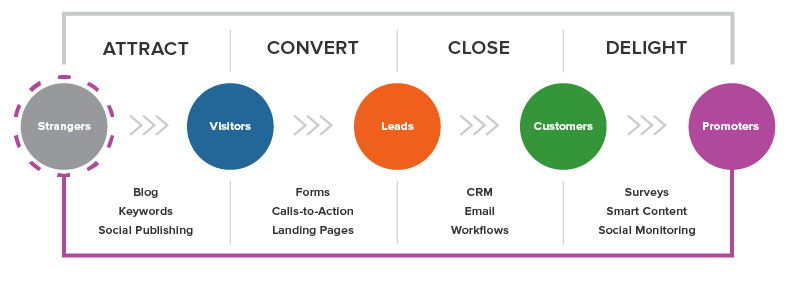Inbound marketing creates brand awareness and attracts new business. You can find dozens of inbound marketing definitions online but nothing beats a simple one.
But hey, isn’t that what the word “Marketing” is supposed to mean? How different is “Inbound Marketing”?
Unlike traditional marketing, the focus is shifted from the seller to the customer.
- Inbound Marketing empowers buyers.
- Inbound Marketing focuses on being found by the customer instead of chasing them down.
- Most importantly, inbound marketing strategies add value to the customer even before the customer has decided to buy, and even AFTER the customer has bought.
The result? You build trust and credibility for your business, and you have customers who are also promoters of your brand. The best way to turn strangers into customers and promoters of your business is through the Inbound Methodology.
Table of Contents
The Four Phases of the Inbound Methodology
Inbound marketing is not a single tactic. It is a collection of strategies and techniques that work well together in capturing your audience’s attention and creating a sale. The inbound methodology consists of four phases, and each customer goes through each phase over time. Each phase has a different purpose and strategy to be used. If there’s one inbound marketing definition you need to know, it’s that the ultimate goal is to turn strangers into customers and then eventually promoters of your brand.
1. Attract
The first step in Inbound Marketing is to attract the right people who are most likely to become leads, and happy customers.
How do we attract these leads? Through relevant content.
This phase consists entirely of creating helpful content that catches the person’s attention. And this can be achieved through:
- Blogging
- Having a clear content marketing strategy
- Social media engagement
A. Blogging
Blogging is probably one of the most obvious way to start generating educational content for your customers. In order to get found, you must start creating content that speaks to them and answers their questions.
B. Content strategy
Content created through your channels such as blogs should be coherent and shouldn’t be all over the place. Having a clear content strategy would allow your content creation processes to be sustainable over the long run.
C. Social Media Engagement
There are a lot of social media channels. But choosing a few ones to focus on in your early inbound marketing phase is the key. Having great content that audiences love is worthy of sharing, and social media is just the right place. Make sure to pinpoint which channels your potential customers are interacting, and engage with them early on.
2. Convert
The next step is to convert these visitors into leads. The goal of every page on your website should be to convert your visitors into leads. Great content would be wasted if the page is not optimized for conversion. But, take note that conversions aren’t online sales. Conversions are meant to take customers to the next phase.
How do we convert these visitors? One of the most important ways to convert is through the use of forms.
Have you ever noticed that business pages usually have forms asking visitors to submit their information? Forms are one of the primary ways to connect with your (potential) customers. Forms should be optimized as well and should catch the audience’s attention and needs.
3. Close
Finally, we’re on the stage to close our leads to customers. We’ve attracted our visitors through great content and converted them to leads. There are several ways to close a lead, and the inbound marketing gives us a lot of ways.
One of the best ways to convert these leads to customers is simply by continuing your efforts from designing the forms that converted them in the first place: email campaigns.
Remember the reason why the lead signed up. Were you offering an e-book? Email campaigns would allow you to continue the conversation and guide your user to the next steps. If leads aren’t ready to be a customer yet, a series of Emails enforces to them the value of your brand until such leads are ready to buy.
4. Delight
Inbound Marketing does not only aim to generate a sale. But it also aims to create a lasting relationship with your customers. The sale doesn’t end the process of Inbound Marketing. In the delight stage, you give your customers the tools needed for their success, an all-star customer service, and content specifically tailored to them.
To summarize, here’s an illustration of the whole Inbound Methodology we just discussed in this article:

Inbound Marketing Definition: Empowered Buyers
The power has been turned over to the consumers. Buyers today are more empowered. They have access to reviews, pricing details, and information on any brand and product. And if your content doesn’t show up, you are losing out to potential customers.
Muggtech is a certified Inbound Marketing agency. Ask us how we can help you with your inbound needs. Request for a free consultation now.



